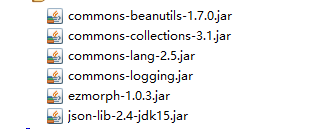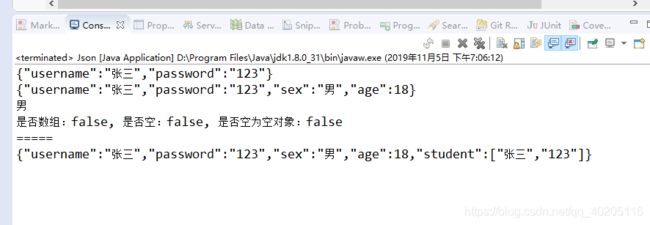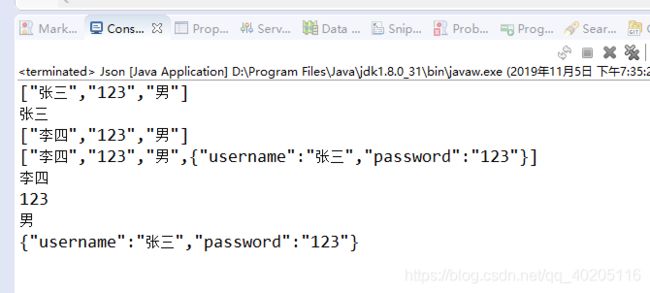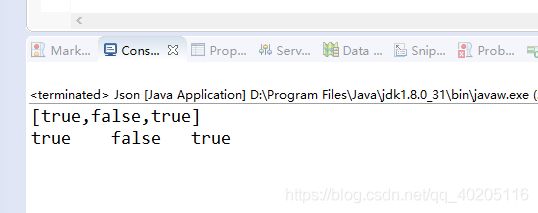JSONObject只是一种数据结构,可以理解为JSON格式的数据结构(key-value 结构),可以使用put方法给json对象添加元素。JSONObject可以很方便的转换成字符串,也可以很方便的把其他对象转换成JSONObject对象。
简介
在程序开发过程中,在参数传递,函数返回值等方面,越来越多的使用JSON。JSON(JavaScript Object Notation)是一种轻量级的数据交换格式,同时也易于机器解析和生成、易于理解、阅读和撰写,而且Json采用完全独立于语言的文本格式,这使得Json成为理想的数据交换语言。
JSON建构于两种结构:
“名称/值”对的集合(A Collection of name/value pairs),在不同的语言中,它被理解为对象(Object), 记录(record), 结构(struct), 字典(dictionary), 有趣列表(keyed list), 哈希表(hash table)或者关联数组(associative array)。
JSONObject依赖:
最后一行需要保留,有两个jdk版本的实现:json-lib-2.1-jdk13.jar和json-lib-2.1-jdk15.jar
net.sf.json-lib json-lib 2.4 jdk15
使用net.sf.json需要导入的jar包
jar包下载:
链接: https://pan.baidu.com/s/1nxwl-R3n6hNVMepT8LWNmw
提取码: p8w8
JSONObject
创建JSONObject,添加属性
//创建JSONObject
JSONObject json = new JSONObject();
//添加属性
json.put("username", "张三");
json.put("password", "123");
//打印
System.out.println(json);
//增加属性
json.element("sex", "男");
json.put("age", 18);
System.out.println(json);
根据key返回输出
System.out.println(json.get("sex"));
判断输出对象的类型
boolean isArray = json.isArray();
boolean isEmpty = json.isEmpty();
boolean isNullObject = json.isNullObject();
System.out.println("是否数组:"+isArray+", 是否空:"+isEmpty+", 是否空为空对象:"+isNullObject);
把JSONArray添加到JSONObject中
/把JSONArray添加到JSONObject中
JSONArray jsonArray = new JSONArray();
jsonArray.add(0, "张三");
jsonArray.add(1, "123");
//开始添加
json.element("student", jsonArray);
System.out.println(json);
全部代码:
import net.sf.json.JSONArray;
import net.sf.json.JSONObject;
public class Json {
public static void main(String[] args) {
//创建JSONObject
JSONObject json = new JSONObject();
//添加属性
json.put("username", "张三");
json.put("password", "123");
//打印
System.out.println(json);
//增加属性
json.element("sex", "男");
json.put("age", 18);
System.out.println(json);
//根据key返回
System.out.println(json.get("sex"));
//判断输出对象的类型
boolean isArray = json.isArray();
boolean isEmpty = json.isEmpty();
boolean isNullObject = json.isNullObject();
System.out.println("是否数组:"+isArray+", 是否空:"+isEmpty+", 是否空为空对象:"+isNullObject);
System.out.println("=====");
//把JSONArray添加到JSONObject中
JSONArray jsonArray = new JSONArray();
jsonArray.add(0, "张三");
jsonArray.add(1, "123");
//开始添加
json.element("student", jsonArray);
System.out.println(json);
}
}
运行结果:
JSONArray
创建JSONArray,添加属性值
//创建JSONArray
JSONArray jsonArray = new JSONArray();
//添加
jsonArray.add(0, "张三");
jsonArray.add(1, "123");
jsonArray.element("男");
System.
根据下标返回输出
System.out.println(jsonArray.get(0));
根据下标设置新值,修改
jsonArray.set(0, "李四"); System.out.println(jsonArray);
把JSONObject放入到JSONArray中
//把JSONObject放入到JSONArray中
JSONObject jsonObject = new JSONObject();
jsonObject.put("username", "张三");
jsonObject.put("password", "123");
jsonArray.add(jsonObject);
System.
全部代码:
import net.sf.json.JSONArray;
import net.sf.json.JSONObject;
public class Json {
public static void main(String[] args) {
//创建JSONArray
JSONArray jsonArray = new JSONArray();
//添加
jsonArray.add(0, "张三");
jsonArray.add(1, "123");
jsonArray.element("男");
System.out.println(jsonArray);
//根据下标返回输出
System.out.println(jsonArray.get(0));
//根据下标设置新值,修改
jsonArray.set(0, "李四");
System.out.println(jsonArray);
//把JSONObject放入到JSONArray中
JSONObject jsonObject = new JSONObject();
jsonObject.put("username", "张三");
jsonObject.put("password", "123");
jsonArray.add(jsonObject);
System.out.println(jsonArray);
//循环输出
for(int i = 0; i < jsonArray.size(); i++) {
System.out.println(jsonArray.get(i));
}
}
}
运行结果
JavaBean与json字符串互转
student类:
public class Student {
private String username;
private String password;
public String getUsername() {
return username;
}
public void setUsername(String username) {
this.username = username;
}
public String getPassword() {
return password;
}
public void setPassword(String password) {
this.password = password;
}
public Student(String username, String password) {
super();
this.username = username;
this.password = password;
}
public Student() {
super();
// TODO Auto-generated constructor stub
}
@Override
public String toString() {
return "Student [username=" + username + ", password=" + password + "]";
}
}
定义对象,JavaBean对象转json字符串
//定义对象
Student stu = new Student("张三", "123456");
//JavaBean对象转json字符串
JSONObject jsonObject = JSONObject.fromObject(stu);
System.out.println(jsonObject);
json字符串转为javaBean
//json字符串转为javaBean
//定义json字符串
String jsondata = "{\"username\":\"李四\", \"password\":\"123\"}";
//转为json对象
JSONObject json = JSONObject.fromObject(jsondata);
//转为JavaBean对象
Student stu2 = (Student)JSONObject.toBean(json, Student.class);
System.out.println(stu2.toString());
全部代码:
import net.sf.json.JSONObject;
public class Json {
public static void main(String[] args) {
//定义对象
Student stu = new Student("张三", "123456");
//JavaBean对象转json字符串
JSONObject jsonObject = JSONObject.fromObject(stu);
System.out.println(jsonObject);
//json字符串转为javaBean
//定义json字符串
String jsondata = "{\"username\":\"李四\", \"password\":\"123\"}";
//转为json对象
JSONObject json = JSONObject.fromObject(jsondata);
//转为JavaBean对象
Student stu2 = (Student)JSONObject.toBean(json, Student.class);
System.out.println(stu2.toString());
}
}
输出结果:
List与json字符串互转
先定义list集合,list转json字符串
//定义list集合
List list = new ArrayList();
list.add(new Student("张三", "123"));
list.add(new Student("李四", "456"));
//list转json字符串
JSONArray jsonArray = JSONArray.fromObject(list);
System.out.println(jsonArray);
json字符串转list
//json字符串转list
List list2 = new ArrayList();
String jsondata = "[{\"password\":\"123\",\"username\":\"张三\"},{\"password\":\"456\",\"username\":\"李四\"}]";
JSONArray jsonArray1 = JSONArray.fromObject(jsondata);
for(int i = 0; i < jsonArray1.size(); i++) {
JSONObject jsonObject2 = jsonArray1.getJSONObject(i);
Student stu2 = (Student)JSONObject.toBean(jsonObject2, Student.class);
list2.add(stu2);
}
System.out.println(list2);
全部代码
import java.util.ArrayList;
import java.util.List;
import net.sf.json.JSONArray;
import net.sf.json.JSONObject;
public class Json {
public static void main(String[] args) {
//定义list集合
List list = new ArrayList();
list.add(new Student("张三", "123"));
list.add(new Student("李四", "456"));
//list转json字符串
JSONArray jsonArray = JSONArray.fromObject(list);
System.out.println(jsonArray);
//json字符串转list
List list2 = new ArrayList();
String jsondata = "[{\"password\":\"123\",\"username\":\"张三\"},{\"password\":\"456\",\"username\":\"李四\"}]";
JSONArray jsonArray1 = JSONArray.fromObject(jsondata);
for(int i = 0; i < jsonArray1.size(); i++) {
JSONObject jsonObject2 = jsonArray1.getJSONObject(i);
Student stu2 = (Student)JSONObject.toBean(jsonObject2, Student.class);
list2.add(stu2);
}
System.out.println(list2);
}
}
运行结果
Map与json字符串互转
定义map集合,Map转json字符串
//定义map集合
Map map = new HashMap();
map.put("1", new Student("张三", "123"));
map.put("2", new Student("李四", "456"));
//Map转json字符串
JSONObject jsonMap = JSONObject.fromObject(map);
System.out.println(jsonMap);
定义字符串map集合,map集合字符串转为map
//定义字符串map集合
String jsondata = "{\"1\":{\"password\":\"123\",\"username\":\"张三\"},\"2\":{\"password\":\"456\",\"username\":\"李四\"}}";
//map集合字符串转为map
Map map2 = (Map)JSONObject.fromObject(jsondata);
Set set = map2.keySet();
//定义迭代器,迭代输出
Iterator ite = set.iterator();
while(ite.hasNext()) {
//取出一个字符串对象
String key = (String)ite.next();
//转为json格式
JSONObject jsonObject = JSONObject.fromObject(map2.get(key));
//转为对象
Student stu = (Student)JSONObject.toBean(jsonObject, Student.class);
System.out.println(key+" "+stu);
}
全部代码
import java.util.HashMap;
import java.util.Iterator;
import java.util.Map;
import java.util.Set;
import net.sf.json.JSONObject;
public class Json {
public static void main(String[] args) {
//定义map集合
Map map = new HashMap();
map.put("1", new Student("张三", "123"));
map.put("2", new Student("李四", "456"));
//Map转json字符串
JSONObject jsonMap = JSONObject.fromObject(map);
System.out.println(jsonMap);
//定义字符串map集合
String jsondata = "{\"1\":{\"password\":\"123\",\"username\":\"张三\"},\"2\":{\"password\":\"456\",\"username\":\"李四\"}}";
//map集合字符串转为map
Map map2 = (Map)JSONObject.fromObject(jsondata);
Set set = map2.keySet();
//定义迭代器,迭代输出
Iterator ite = set.iterator();
while(ite.hasNext()) {
//取出一个字符串对象
String key = (String)ite.next();
//转为json格式
JSONObject jsonObject = JSONObject.fromObject(map2.get(key));
//转为对象
Student stu = (Student)JSONObject.toBean(jsonObject, Student.class);
System.out.println(key+" "+stu);
}
}
}
运行结果
JSONArray与List互转
定义list集合,List转型JSONArray
//定义list集合 Listlist = new ArrayList (); list.add(new Student("张三", "123")); list.add(new Student("李四", "456")); //List转型JSONArray JSONArray jsonArray = JSONArray.fromObject(list); System.out.println(jsonArray.toString());
JSONArray转型List,JSONArray是用的上面的那个jsonArray变量
//JSONArray转型List Listlist2 = JSONArray.toList(jsonArray, new Student(), new JsonConfig()); Iterator ite = list2.iterator(); while(ite.hasNext()) { Student stu = ite.next(); System.out.println(stu); }
全部代码
import java.util.ArrayList;
import java.util.Iterator;
import java.util.List;
import net.sf.json.JSONArray;
import net.sf.json.JsonConfig;
public class Json {
public static void main(String[] args) {
//定义list集合
List list = new ArrayList();
list.add(new Student("张三", "123"));
list.add(new Student("李四", "456"));
//List转型JSONArray
JSONArray jsonArray = JSONArray.fromObject(list);
System.out.println(jsonArray.toString());
//JSONArray转型List
List list2 = JSONArray.toList(jsonArray, new Student(), new JsonConfig());
Iterator ite = list2.iterator();
while(ite.hasNext()) {
Student stu = ite.next();
System.out.println(stu);
}
}
}
运行结果
JSONArray与数组互转
定义数组,数组转JSONArray
//定义数组
boolean[] boolArray = {true, false, true};
//java数组转JSONArray
JSONArray jsonArray = JSONArray.fromObject(boolArray);
System.out.println(jsonArray.toString());
JSONArray转java数组
//JSONArray转java数组
Object obj[] = jsonArray.toArray();
for(Object o : obj) {
System.out.print(o+"\t");
}
全部代码
import net.sf.json.JSONArray;
public class Json {
public static void main(String[] args) {
//定义数组
boolean[] boolArray = {true, false, true};
//java数组转JSONArray
JSONArray jsonArray = JSONArray.fromObject(boolArray);
System.out.println(jsonArray.toString());
//JSONArray转java数组
Object obj[] = jsonArray.toArray();
for(Object o : obj) {
System.out.print(o+"\t");
}
}
}
运行结果
到此这篇关于浅谈JSONObject的使用及示例代码(JSON解析)的文章就介绍到这了,更多相关JSONObject使用方法内容请搜索脚本之家以前的文章或继续浏览下面的相关文章希望大家以后多多支持脚本之家!







